Uchanie
Borough of Uchanie, Hrubieszów District, Lubelskie VoivodshipType of place
Jewish cemeteryInformation about the crime
The ghetto in Uchanie existed since 1941. The Jews from Uchanie and surrounding villages as well as from Łowicz and Łódź were imprisoned there. The prisoners of the ghetto (including women and children) were used for snow removal and road repairs. The Jews were absolutely forbidden to leave the designated area under threat of death penalty. But because there was a permanent lack of everything in the ghetto many people took the risk, thus singular or mass murders happened often. Victims were killed either on the Jewish cemetery or wherever they were stopped – in which case their bodies were taken to the cemetery and buried there. “I remember the Germans executing single Jews and also [conducting] mass executions. Single executions happened when the Germans caught a Jew in a village near Uchanie. […] For mass shootings of the Jews special German crews would arrive.” (IPN Lu 284/467 vol.1)
The following murders happened in the village of Uchanie. According to the witnesses testifying during the investigation number OKL/Ds. 353/67 (with regard to the Jewish work camp and the ghetto in Uchanie, Hrubieszów District), bodies of the victims were buried on the local Jewish cemetery:
- In 1940 five or six people were murdered on the cemetery for sympathising with communists and wearing red armbands in 1939 during the Soviet occupation. “In the spring of 1941 I saw three military policemen from the police station in Teratyn whose names I didn’t know shooting 5 young Jews suspected of communism. The killing took place in the ravine between the Jewish cemetery and the Catholic (Polish) cemetery. […] I was [standing] in my own yard which was located near both cemeteries. It was about 60 metres from the place I was standing to the place the Jews were killed. The victims were: a son of a Jewish cobbler Pejsach nicknamed ‘Picipunek’ due to his small stature and a son of a ropemaker called Ideł.” (IPN Lu 284/467 vol.1)
- The same witness testified as well: “Another time I saw a military policeman (unknown to me) from the police station in Teratyn killing two Jews I knew with gunshots: Kiwa Klajner and Josz Birman, local merchants.” (IPN Lu 284/467 vol.1)
- During the Pentecost in 1940 or 1941 forty men were murdered on the cemetery – mostly elderly and disabled. “[…] Around 3 pm I saw the Germans shooting 40 elderly Jews on the Jewish cemetery. While being led, the Jews passed my house. They were brought to the Jewish cemetery, placed in groups of 10 in front of a ditch and then shot from automatic guns by several Germans. Bodies of the victims were buried by young Jews brought there with spades by the Germans. The Jews dug a large ditch and buried the dead. […] I saw the murder of 40 Jews from a distance of about 100 metres.” (IPN Lu 284/467 vol.1)
- In 1943, after the liquidation of Uchanie ghetto, around 30 people were still hiding in local forests, including women and children. One day the forest was surrounded by the Germans and Ukrainians and the hiding Jews were murdered. Their bodies were probably buried in the forest.
- “[…] After the Uchanie ghetto liquidation, Maks [a military policeman from the police station in Uchanie who could speak Polish] was capturing [Jews] who had been hiding and shot them on [the Jewish cemetery.] I saw it. In my presence he shot two Jewish men and two Jewish women. These Jews were called Cudyk Szafran, Moszek Kutia i Ludner – I don’t know her first name. I don’t know the surname of the other Jewish woman.” (IPN Lu 284/467 vol.1.) Death of a Jew called Cudyk was observed by another resident of Uchanie: “[…] I remember that one day after 8 pm a Jew called Cudyk, about 60 years old, was walking back from the village. A German man from the local military police station stopped him. In Uchanie we used to know him as Maks. I saw Maks leading [the Jew] to the cemetery that evening. He shot him there. Later on, a son of this Jew came to me and told me that his father was shot on the cemetery.” (IPN Lu 284/467 vol.1.) The same event was mentioned by another witness: “I saw Maks leading Szafran Cudyk, Fajge Ludner and Mojsze Kuć towards the Jewish cemetery. Later on, I heard gunshots and saw Maks returning alone.” (IPN Lu 284/467 vol.1.)
- The aforementioned military policeman Maks has been remembered in Uchanie as a sadist who killed many people: “I saw Maks killing two Jews with gunshots on the Jewish cemetery – a young 18-year-old boy and another one, a bit older. I was cycling past the cemetery then and I saw the killing from a 15 metres distance. I don’t remember the names of the victims but they were Jews from Uchanie.” (IPN Lu 284/467 vol.1.)
- “I remember that in the late autumn of 1943 I saw Schumacher [a German military policeman from Teratyn] and another military policeman leading two Jews to the Jewish cemetery in Uchanie. One of the Jews walked barefoot on ice. Shortly after I heard two gunshots in about 200 metres distance. […] Stanisław Szewczuk told me that Schumacher shot a Jewish woman called Necha Dajcz in his presence.” (IPN Lu 284/467 vol.1.)
- “In early September 1942 I witnessed the shooting of an elderly woman Pinkwas [an owner of a shop in Uchanie] and her two grandchildren, an 8-year-old boy and a 6-year-old girl, by a German military policeman from Teratyn whose name I didn’t know. The policeman brought Mrs Pinkwas and her grandchildren in a cart from the direction of the town to the Jewish cemetery. There he ordered her to get off the cart and led her to the cemetery together with the children. Once they got there, he killed them with shots in the head – first her and then the children. […] Mrs Pinkwas’ husband, Pinkwas Chorenfeld, was a cereal merchant.” (IPN Lu 284/467 vol.1.)
- “Another time I saw an unknown military policeman from Teratyn shooting an old Jewish man who came from Uchanie and worked as a cereal merchant. The killing took place on the Jewish cemetery. The military policeman shot him in the back of the head. It happened in September 1942.” (IPN Lu 284/467 vol.1.)
- “I saw Schultz [a military policeman from the police station in Teratyn] shooting two young Jewish women of unknown names from Łódź on the Jewish cemetery in Uchanie.” (IPN Lu 284/467 vol.1.)
IDENTIFICATION OF THE GRAVE BASED ON NON INVASIVE RESEARCH
On the 25th of August 2015, a site location in the Jewish cemetery was carried out during which an approximate place of amass grave was indicated (GPS: N 50°54.198′ E 023°38.823′). It took a place without the presence of the witness.
No GPR surveys were conducted.
The LIDAR survey indicates numerous ground disturbances in this location.
The aerial photography query for this area wasn’t ordered.
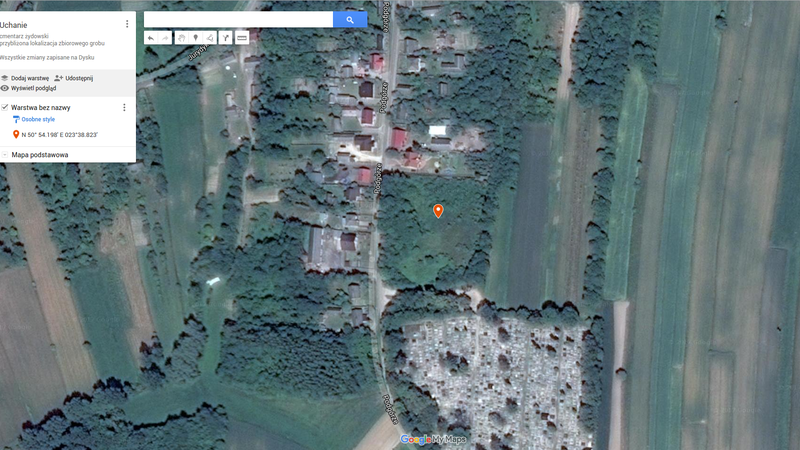 Uchanie fotografia satelitarna 1f
Uchanie fotografia satelitarna 1f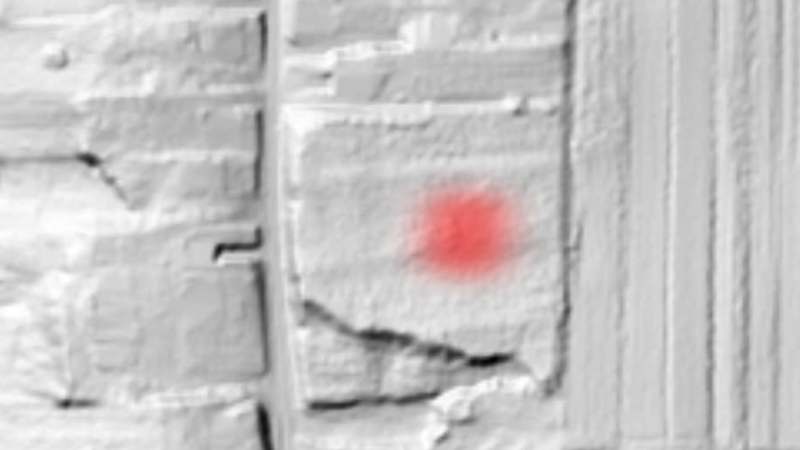 Uchanie lidar 1d
Uchanie lidar 1d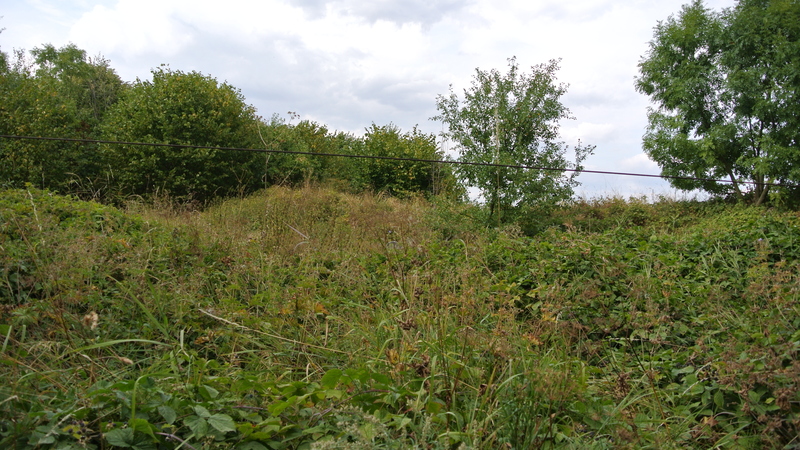 Uchanie fotografia 1 lokalizacji
Uchanie fotografia 1 lokalizacjiSources
Transkrypcje
Contact and cooperation
We are still looking for information on the identity of the victims and the location of Jewish graves in Uchanie. If you know something more, write to us at the following address: fundacjazapomniane@gmail.com.
Bibliography
Resource of the Zapomniane Foundation, three photos of matzevot from the cemetery in Uchanie from 2014.
Recording of the Zapomniane Foundation, name: [witness …], b. [ ], place of residence:…, subject and keywords: Jewish graves in Uchanie, interviewed by Agnieszka Nieradko, Uchanie, date of the recording.
Gmina Uchanie w latach 1918-1939, Biblioteka Towarzystwa Regionalnego Hrubieszowskiego, Volume 18, Hrubieszów 1991.
Typescript of memories from memories of Mr. Jerzy b. in 1921 in Uchanie, written in February 2014.
IPN BU 2448/560, the Chief Commission for the Examination of German Crimes in Poland, Archives of Lublin province, Hrubieszów district.
IPN BU 2448/559, Questionnaires of the Chief Commission for the Examination of German Crimes in Poland Questionnaires regarding lubelskie province – VIII, Hrubieszów district.
GK 195/VIII/7, Scout alert.
IPN Lu 284/467, vol. 1, Crimes committed by the staff of the labor camp and ghetto for people of Jewish nationality in 1940-1942 in Uchanie, Hrubieszów district, i.e. an offense under Art. 1 item 1 of the Decree of 31/08/1944 – main files.
IPN Lu 284/467, vol. 2, Crimes committed by the staff of the labor camp and ghetto for people of Jewish nationality in 1940-1942 in Uchanie, Hrubieszów district, i.e. an offense under Art. 1 item 1 of the Decree of 31/08/1944 – reference files.
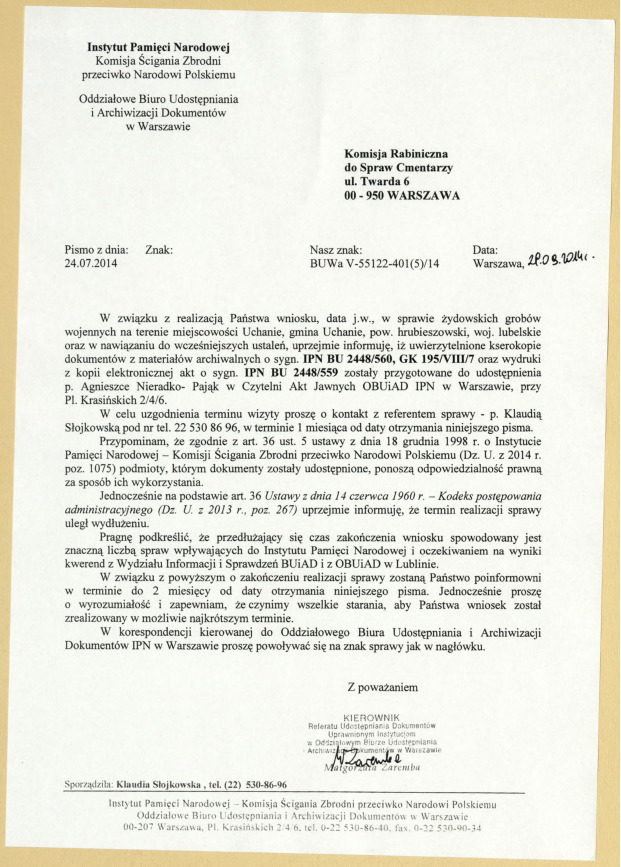 Ankiety Głównej Komisji Badania Zbrodni Hitlerowskich w Polsce (…)
Ankiety Głównej Komisji Badania Zbrodni Hitlerowskich w Polsce (…)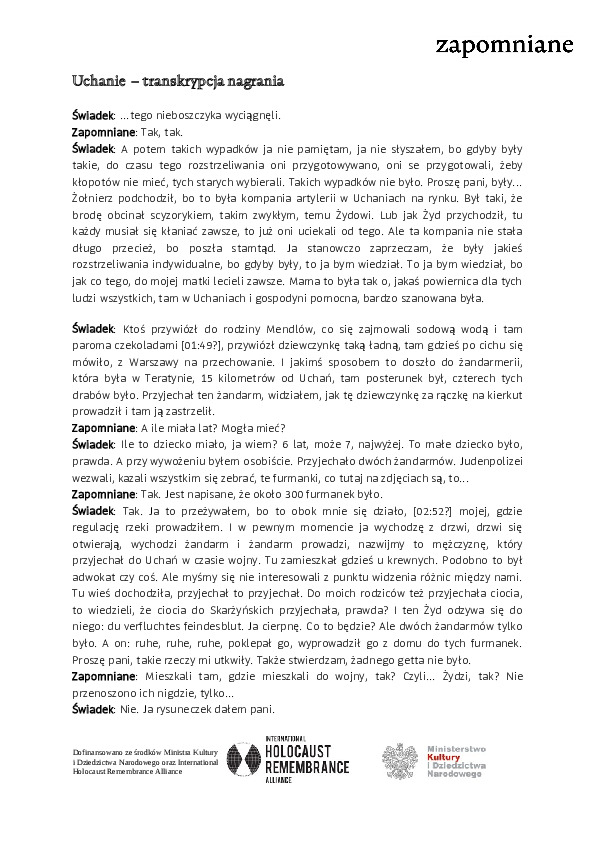 Uchanie - transkrypcje nagrania
Uchanie - transkrypcje nagrania